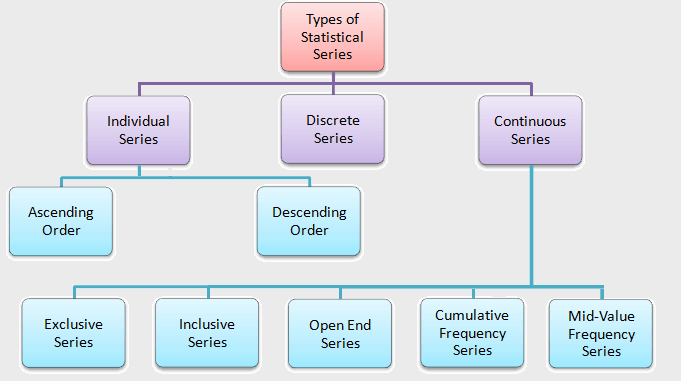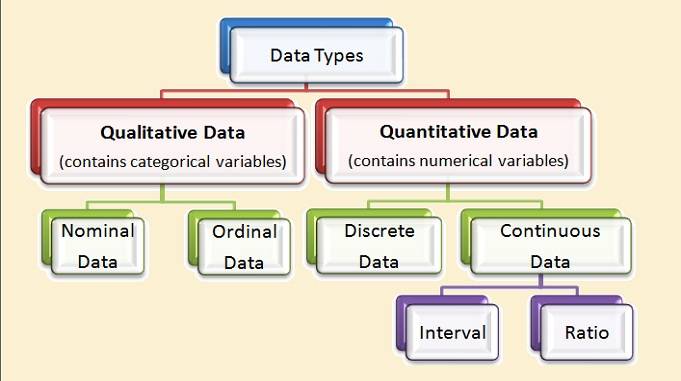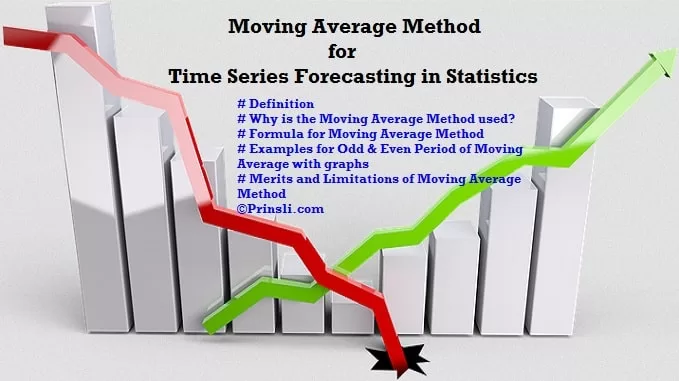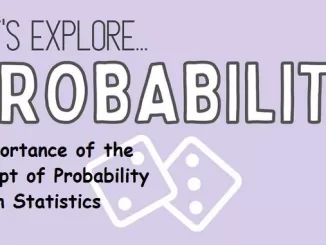
Exclusive Series:
Exclusive series is a kind of continuous series, in which the upper limit of any class interval is equal to the lower limit of the next class interval. An exclusive series is one in which every class interval excludes the value of its upper limit.
For example; continuous series such as 0-10, 10-20, 20-30… is called an exclusive series. In such an exclusive series, the upper limit of one class is the lower limit of the next class. That is, the individual observation ’10’ is the upper limit of the class 0-10 but the lower limit of the next class 10-20. Similarly, the individual observation ’20’ is the upper limit of 10-20 but a lower limit of 20-30.
Because in this type of series, the value of the upper limit of any class interval is not included in that class interval but is included in the next class interval, so it is referred to as an exclusive series or overlapping series.
In other words, when the data are classified in such a way that the upper limit of any class interval is equal to the lower limit of the next class interval, then it is called the exclusive method of classifying data. Because the upper limit of each class interval is equal to the lower limit of the next class interval, such classification ensures data continuity.
Remember that no data value can fall into more than one class interval. To maintain the various class intervals mutually exclusive, the data values, greater than or equal to the lower limit but less than the upper limit of any class, are included in it.
For example, in the exclusive series 0-10, 10-20, 20-30, 30-40, …, notice that the upper limit of one class is the lower limit for the next class. Here, a question of where the individual observation of 10 should be placed arises. According to tradition, it is placed to the next class, i.e., the class 10-20. As a result, the 0-10 class means 0 and greater than 0 but less than 10. Similarly, class 10-20 means 10 and more than 10 but less than 20.
For example, in the exclusive series 100-150, 150-200, 200-250, 250-300; then an individual value 200 will be included in the class interval 200-250 rather than the class interval 150-200.
Example of an Exclusive Series:
The following are the marks scored by the 20 students in a class out of a total of 100. If the marks scored by the 20 students in the class are given individually, it will form an Individual series, as shown follows:
90, 55, 35, 78, 51, 57, 60, 55, 55, 85, 78, 80, 35, 41, 61, 55, 62, 64, 55, 19.
This data can be represented in an exclusive series as follows:
|
Marks (X) Class-intervals |
No. of Students
(Frequency f) |
|
0-20 |
1 |
|
20-40 |
2 |
|
40-60 |
8 |
| 60-80 |
6 |
| 80-100 |
3 |
| Total |
20 |
Exclusive Series in Hindi
अपवर्जी श्रेणी या असम्मिलित श्रेणी (Exclusive Series):
अपवर्जी श्रेणी एक प्रकार की सतत श्रृंखला है, जिसमें किसी वर्ग अंतराल की ऊपरी सीमा (उच्च सीमा) अगले वर्ग अंतराल की निचली सीमा (निम्न सीमा) के बराबर होती है। अपवर्जी श्रेणी में प्रत्येक वर्ग अंतराल अपनी ऊपरी सीमा के मान को बाहर कर देता है, अर्थात प्रत्येक वर्ग की वर्ग आवृत्ति की गणना करते समय उस वर्ग की उच्च सीमा की गणना उस वर्ग में ना करके उससे अगले वर्ग में की जाती है। इस प्रकार प्रत्येक वर्ग से उसकी उच्च सीमा छोड़ दी जाती है और अगले वर्ग में सम्मिलित (शामिल) कर ली जाती है।
उदाहरण के लिए; सतत श्रृंखला जैसे 0-10, 10-20, 20-30… को अपवर्जी श्रृंखला कहा जाता है। इस अपवर्जी श्रृंखला में, किसी भी वर्ग की ऊपरी सीमा अगले वर्ग की निचली सीमा है। यानी व्यक्तिगत प्रेक्षण ’10’ वर्ग 0-10 की ऊपरी सीमा है लेकिन अगले वर्ग 10-20 की निचली सीमा है। इसी तरह, व्यक्तिगत अवलोकन ’20’ वर्ग 10-20 की ऊपरी सीमा है लेकिन वर्ग 20-30 की निचली सीमा है।
क्योंकि इस प्रकार की श्रृंखला में, किसी वर्ग अंतराल की ऊपरी सीमा का मान उस वर्ग अंतराल में शामिल नहीं होता है, बल्कि अगले वर्ग अंतराल में शामिल होता है, इसलिए इसे अपवर्जी श्रृंखला, असम्मिलित श्रृंखला या अतिव्यापी श्रृंखला के रूप में संदर्भित किया जाता है।
दूसरे शब्दों में, जब आँकड़ों को इस प्रकार वर्गीकृत किया जाता है कि किसी वर्ग अंतराल की ऊपरी सीमा अगले वर्ग अंतराल की निचली सीमा के बराबर हो, तो इसे आँकड़ों को वर्गीकृत करने की अपवर्जी विधि कहते है। चूंकि प्रत्येक वर्ग अंतराल की ऊपरी सीमा अगले वर्ग अंतराल की निचली सीमा के बराबर होती है, इसलिए ऐसा वर्गीकरण डेटा की निरंतरता को सुनिश्चित करता है।
याद रखें कि कोई भी डेटा मान एक से अधिक वर्ग अंतराल में नहीं आ सकता है। विभिन्न वर्ग अंतरालों को परस्पर अपवर्जी बनाए रखने के लिए, इसमें किसी भी वर्ग की निम्न सीमा से अधिक या उसके बराबर लेकिन किसी भी वर्ग की उच्च सीमा से कम डेटा मानों को शामिल किया जाता है।
उदाहरण के लिए, अपवर्जी श्रृंखला 0-10, 10-20, 20-30, 30-40, … में ध्यान दें कि एक वर्ग की ऊपरी सीमा अगले वर्ग के लिए निचली सीमा है। यहाँ, एक प्रश्न उठता है कि 10 के व्यक्तिगत अवलोकन को कहाँ रखा जाना चाहिए। परंपरा के अनुसार, इसे अगली कक्षा, यानी कक्षा 10-20 में रखा जाता है। नतीजतन, 0-10 वर्ग का अर्थ है 0 और 0 से बड़ा लेकिन 10 से कम। इसी तरह, कक्षा 10-20 का अर्थ है 10 और 10 से अधिक लेकिन 20 से कम।
उदाहरण के लिए, अपवर्जी श्रृंखला 100-150, 150-200, 200-250, 250-300 में एक व्यक्तिगत मान ‘200’ को वर्ग अंतराल 150-200 के बजाय वर्ग अंतराल 200-250 में शामिल किया जाएगा।
(Source – Various books from the college library)
Copyrighted Material © 2019 - 2024 Prinsli.com - All rights reserved
All content on this website is copyrighted. It is prohibited to copy, publish or distribute the content and images of this website through any website, book, newspaper, software, videos, YouTube Channel or any other medium without written permission. You are not authorized to alter, obscure or remove any proprietary information, copyright or logo from this Website in any way. If any of these rules are violated, it will be strongly protested and legal action will be taken.





Be the first to comment